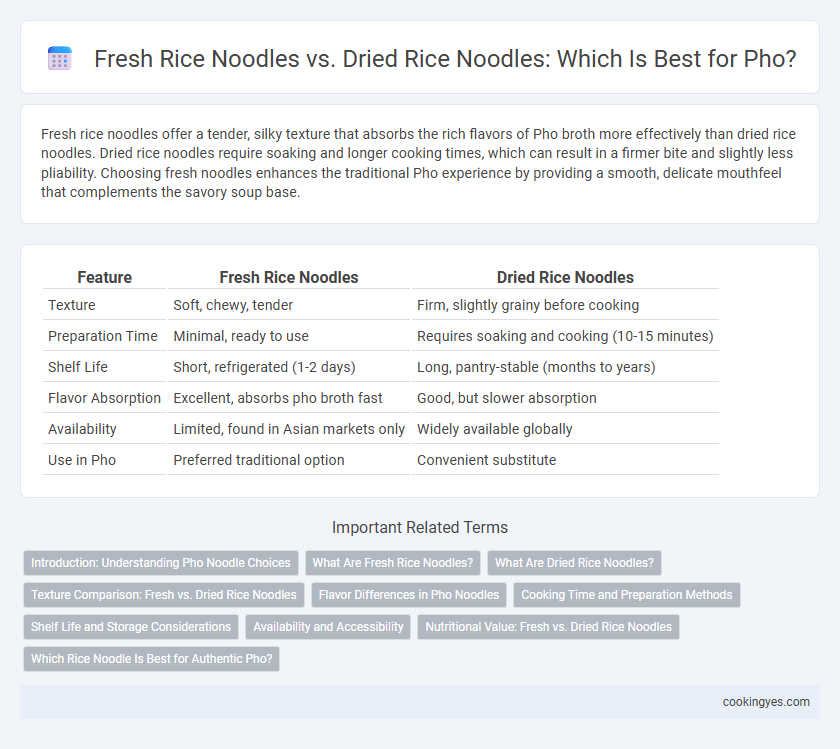Fresh rice noodles offer a tender, silky texture that absorbs the rich flavors of Pho broth more effectively than dried rice noodles. Dried rice noodles require soaking and longer cooking times, which can result in a firmer bite and slightly less pliability. Choosing fresh noodles enhances the traditional Pho experience by providing a smooth, delicate mouthfeel that complements the savory soup base.
Table of Comparison
| Feature | Fresh Rice Noodles | Dried Rice Noodles |
|---|---|---|
| Texture | Soft, chewy, tender | Firm, slightly grainy before cooking |
| Preparation Time | Minimal, ready to use | Requires soaking and cooking (10-15 minutes) |
| Shelf Life | Short, refrigerated (1-2 days) | Long, pantry-stable (months to years) |
| Flavor Absorption | Excellent, absorbs pho broth fast | Good, but slower absorption |
| Availability | Limited, found in Asian markets only | Widely available globally |
| Use in Pho | Preferred traditional option | Convenient substitute |
Introduction: Understanding Pho Noodle Choices
Fresh rice noodles offer a soft, chewy texture that absorbs the rich, aromatic broth of pho, enhancing the overall flavor experience. Dried rice noodles provide a longer shelf life and convenience but require careful rehydration to avoid a brittle or overly soft consistency that can detract from authenticity. Selecting between fresh and dried rice noodles depends on availability, preparation time, and desired texture, directly impacting the traditional pho presentation.
What Are Fresh Rice Noodles?
Fresh rice noodles for Pho are made from rice flour and water, formed into thin sheets and quickly steamed before being cut into strips, resulting in a soft, tender texture that absorbs broth flavors well. Unlike dried rice noodles, fresh ones have higher moisture content, providing a chewier and more delicate bite characteristic of authentic Pho. They are typically found in refrigerated sections of Asian markets and cook faster, making them ideal for traditional Vietnamese Pho dishes.
What Are Dried Rice Noodles?
Dried rice noodles are rice-based noodles that undergo a dehydration process, removing moisture to extend shelf life and facilitate storage and transport. Unlike fresh rice noodles, which are soft and pliable with a delicate texture, dried rice noodles require soaking or boiling to rehydrate before cooking in pho dishes. The dehydration process can cause dried rice noodles to have a slightly firmer texture, which holds up well in the hot broth of traditional Vietnamese pho.
Texture Comparison: Fresh vs. Dried Rice Noodles
Fresh rice noodles offer a tender, silky texture that absorbs pho broth flavors quickly, creating a smooth and delicate eating experience. Dried rice noodles tend to be firmer and chewier after cooking, providing a more resilient bite that holds up well in richer, spicier broths. Choosing between fresh and dried rice noodles often depends on desired texture and broth compatibility in authentic pho preparation.
Flavor Differences in Pho Noodles
Fresh rice noodles in pho offer a delicate, chewy texture and absorb the broth's aroma more effectively, enhancing the overall flavor complexity. Dried rice noodles tend to have a firmer bite and a slightly grainier taste, which can overpower subtle broth notes. The choice between fresh and dried noodles significantly influences the sensory experience of traditional Vietnamese pho.
Cooking Time and Preparation Methods
Fresh rice noodles for Pho cook much faster, typically requiring only a brief soak in hot water for 1-2 minutes to achieve the ideal tender texture. Dried rice noodles demand longer preparation, often needing a 20-30 minute soak followed by boiling to fully rehydrate and soften. Choosing fresh noodles ensures quicker assembly and a traditional, silky consistency preferred in authentic Pho recipes.
Shelf Life and Storage Considerations
Fresh rice noodles for pho offer a soft texture and optimal flavor but have a short shelf life, typically lasting only 2-3 days when refrigerated. Dried rice noodles boast a significantly longer shelf life, often up to 12 months, and require dry, cool storage conditions to maintain quality. Choosing between fresh and dried noodles depends on storage capabilities and desired pho authenticity.
Availability and Accessibility
Fresh rice noodles for Pho are widely available in Asian supermarkets and specialty stores, often sold in refrigerated sections to maintain their soft texture and delicate flavor. Dried rice noodles offer greater accessibility since they have a longer shelf life, are easier to store, and can be found in most grocery stores, including international aisles and online platforms. Both types cater to different needs, with fresh noodles preferred for authentic Pho experiences and dried noodles favored for convenience and wider distribution.
Nutritional Value: Fresh vs. Dried Rice Noodles
Fresh rice noodles used in Pho retain higher moisture content and preserve more nutrients such as B vitamins and antioxidants compared to dried rice noodles, which undergo processing that can reduce their nutritional profile. Dried rice noodles offer longer shelf life and convenience but may contain slightly higher glycemic index values due to the drying process altering starch structure. Both types provide similar calorie counts and carbohydrate content, but fresh noodles are generally preferred for nutrient density and texture in authentic Pho.
Which Rice Noodle Is Best for Authentic Pho?
Fresh rice noodles are preferred for authentic Pho due to their soft, chewy texture and ability to absorb the rich, aromatic broth, enhancing the overall flavor profile. Dried rice noodles, while convenient and longer-lasting, often lack the delicate smoothness and elasticity characteristic of traditional Pho served in Vietnamese restaurants. Choosing fresh rice noodles made from high-quality rice flour contributes to a more genuine and satisfying Pho experience.
Fresh rice noodles vs dried rice noodles for Pho noodles Infographic

 cookingyes.com
cookingyes.com